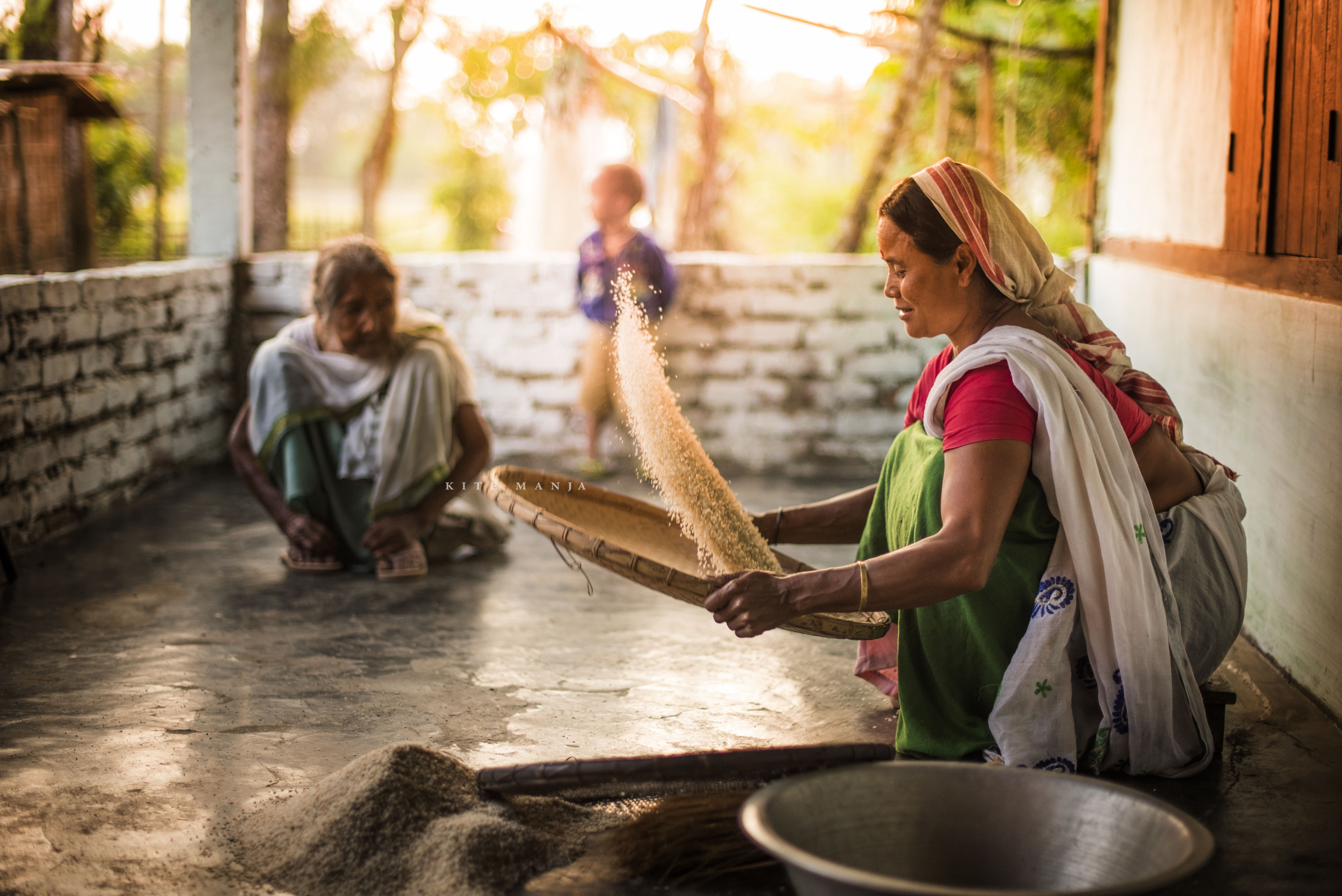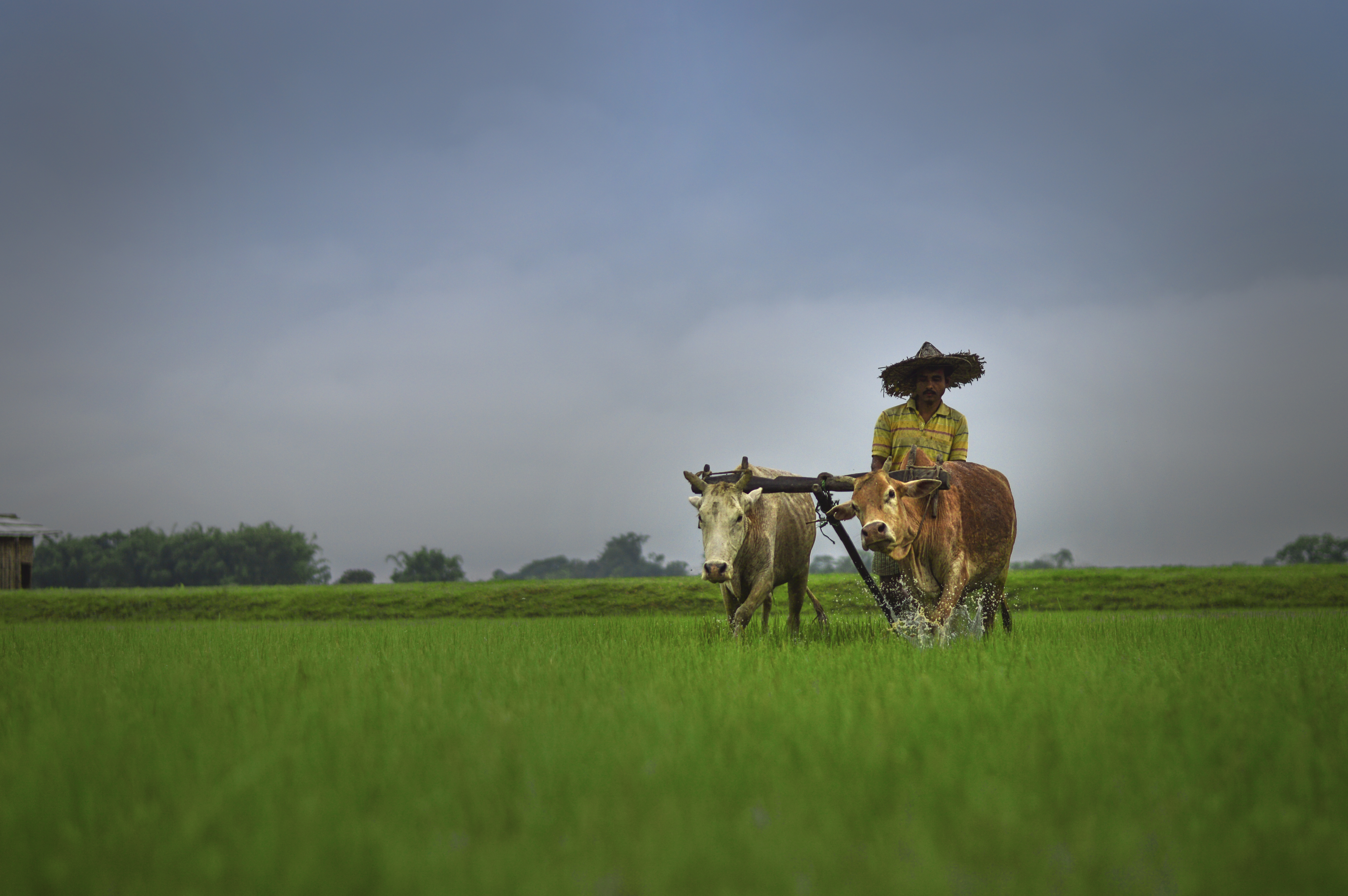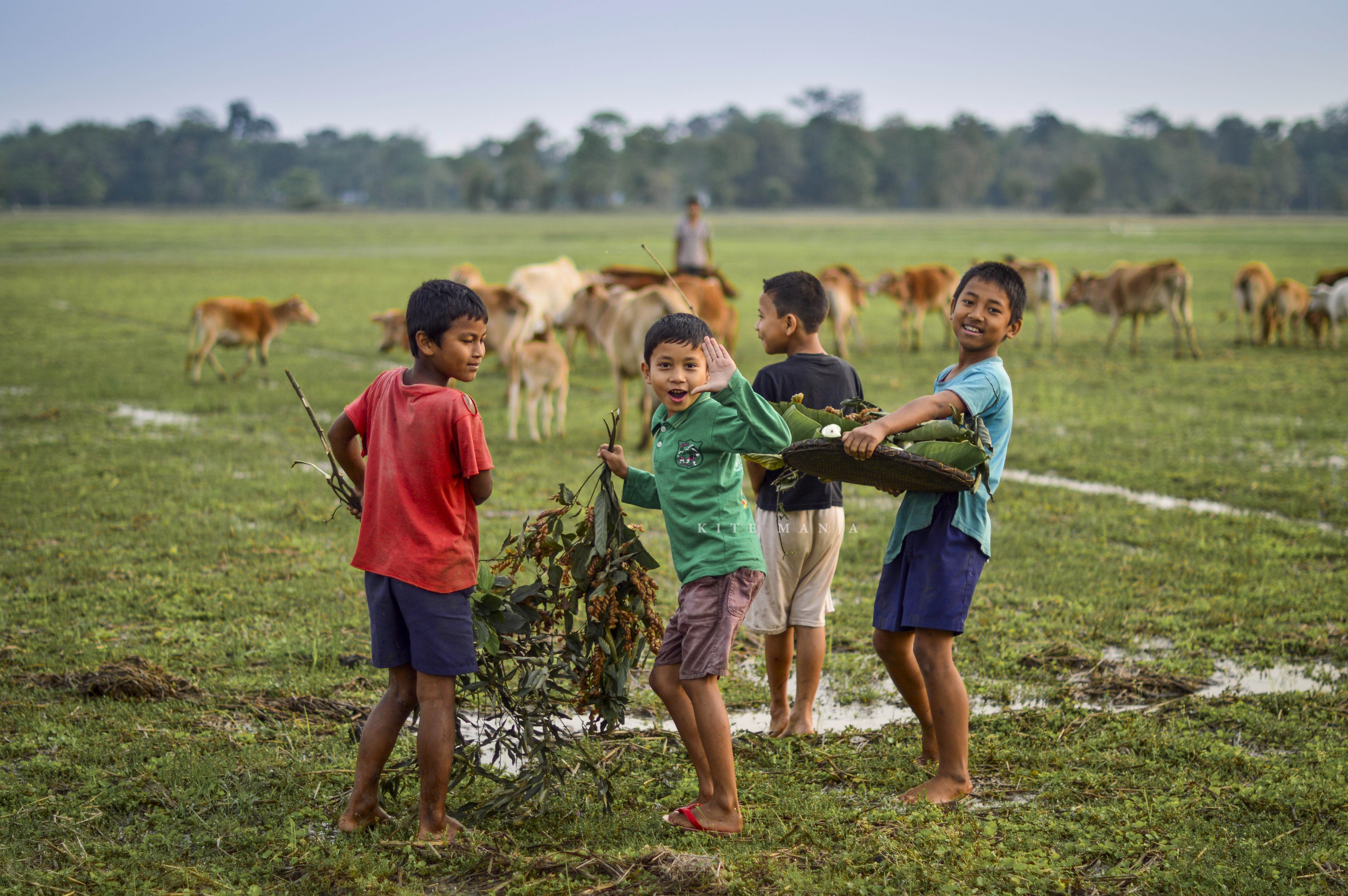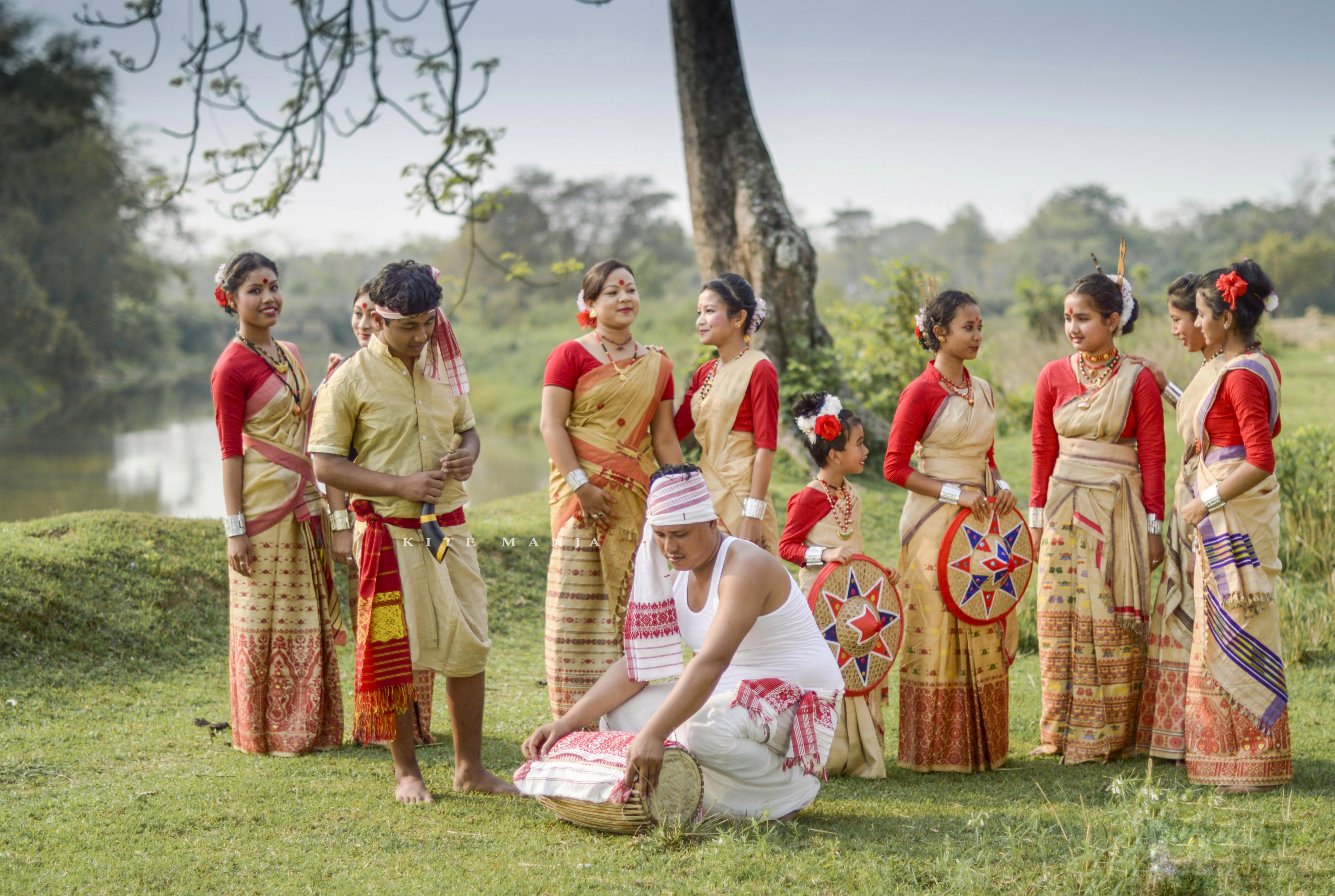As the dry season gets over and brings green fertile landscape, flowers like Kopou (Foxtail Orchid), Togor (Wax Flower), and Nahor (Ironwood Flower) bloom to signify the arrival of spring. Blooming of these flowers marks the arrival of a graceful festival called Bohag Bihu. It is a harvest festival which the people of Assam celebrate with pomp & gaiety. Bohag Bihu is synonymous with the state’s strong agrarian culture and sentiment where people seek blessings from the god for the sowing season and also marks the Assamese New Year.
This festival of merriment is also known as Rongali Bihu. It reflects the emotion of joyfulness and the change in the seasonal cycle. Everyone in the household will be busy with their part in the process of celebrations. The youngsters will be seen practicing Bihu dance on the beating tunes of ‘Dhool’ (drum) and the farmers prepare for fresh cultivation of paddy. The women will make traditional sweets like ‘Pitha’ and ‘laru’ using rice flour, coconut and jaggery which are first offered to the gods and later served to the guests.
Bohag Bihu Then and Now
To know the history of Bohag Bihu, we will have to first understand the word ‘Bihu’. Surprisingly, there is no actual meaning for this word, it is a feeling! It is an inner feeling of a farmer about the different stages in the agricultural cycle of the paddy cultivation. It can be a state of happiness as well as worry and this is the reason due to which Bihu is celebrated thrice a year to recognize these phases.
The three Bihus depicting different phases are Bohag or Rongali Bihu (Festival of Happiness), Kati or Kongali Bihu (Festival of Scarcity) and Magh or Bhogali Bihu (Festival of Feasting). The former is the most important one because it also falls during the time of the Assamese New Year.
Over the time of its existence, these phases of feeling became the cultural identity of the Assamese community. Researchers believe that the custom of celebrating Bohag Bihu is as old as the River Brahmaputra and exist from the time when man started tilling of the earth for sustenance. Songs associated with agricultural activities have long been a part of many communities in rural India and so was in Assam. Farmers used to sing at the time of sowing and dance during their leisure time due to which Bihu songs and dance became a unique feature of Bohag Bihu celebrations.
Transformation of Songs & Dance in Bihu
From the period it got inherited in the Assamese society to the present time, Bihu songs and dance has undergone many transformations. Be it a pattern of Bihu song lyrics or the dance postures, a lot has been evolved over time.
Bihu songs are based on the themes of love, desire and sadness. When with a group of friends, it’s the way of expressing suppressed longing and desires for a boy or a girl. The Ahom dynasty patronized the Bihu songs and dance in Sivasagar in its true form. It is because of their cultural agenda due to which Bihu was inculcated as a cultural identity of the state. Unlike the love songs, the songs with praises of the Ahom king (Swargadeu) were used to be performed. During the seven days of the festival, the royal family used to enjoy such Bihu performances (Husori) in the courtyard of the ‘Rangghar’ (a house of joy) and it got widely accepted in a form of a festival.
Later in the 15th and 16th century, the philosophies of Neo-Vaishnavite Movement of Shri Sreemanta Sankardeva introduced an element of spirituality in the Bihu lyrics. From this era, Bihu Husoris started with opening verses of the song dedicated to the gods. To get blessings from the dance troupe by the family members at the end of the dance performance also became a tradition.
The British colonialism brought an ultimate change to the social life of Assam and to the Bihu in general. The farmer class turned in to industrial manpower which resulted in a capitalist consciousness and contraction of agricultural ethos. This contraction led to the usage of commodities which were of materialistic value and the lifestyles around it were getting expressed in the Bihu songs. At this time, a decent population of Assamese youth ventured out to different places in search of job opportunities. Such migration of workers resulted in an ideal cultural exchange within the state due to which Bohag Bihu got considered as a mainstream festival by the people of Assam irrespective of caste, creed and religion.
The pressure of modern day life has hit the modes of Bihu celebrations in the cities and towns. The present-day form of Bihu songs and dance is a mix of an old cultural art form and modern ideas. Nowadays stage functions are organized where dance competitions and musical shows are held. The real joy of this festival can only be felt in the villages where its originality and emotions are very much alive.
7 Days of Bohag Bihu
Bohag Bihu is celebrated over seven phases or days known as Xaat (Seven in Assamese) Bihu where a sheer sense of joy can be felt all over the region. Celebratory dance rehearsals usually start a month is advance till the last day of Chaitra (last month according to the Assamese Lunar calendar). The seven days or phases of Bohag or Rongali Bihu are Raati Bihu, Goru Bihu, Manuh Bihu, Gosain Bihu, Kutum Bihu, Mela Bihu and Chera Bihu.
Raati Bihu – Raati means night and as the name depicts it starts from the first night of Chait. It is primarily a gathering of women in open field illuminated with fire lamps where they perform Bihu dance at night.
Goru Bihu – It falls on the last day of the Chait month (Assamese New Year’s Eve). Goru in Assamese means a Cow and on this day cows are brought near a water source and thoroughly cleaned using raw turmeric and black gram paste. They are offered with food and prayers are offered to thank them for their help in the fields.
Manuh Bihu – It is the Bihu for the humans (Manuh) where homes are cleaned and people have a bath using turmeric and black gram paste. Family members pay respect to the elders by offering a Bihuwan (gift offered in respect) usually a ‘Gamusa’ having a distinctive symbolic significance in the Assamese culture. On this day a special dish made up of 101 different herbs is prepared in parts of Northern Assam.
Gosain Bihu – On the occasion of the Gosain Bihu, prayers are offered and spiritual songs are sung in the prayer hall inside the house and in Naam Ghar (community prayer hall) to pay respect to the gods and to seek their blessings for a good yield.
Kutum Bihu – On this day people visit relatives and neighbors to bond together over a scrumptious ethnic meal.
Mela Bihu – This day marks the Bihu celebrations with outdoor cultural events and competitions. The fairs are held in order to foster communal harmony and brotherhood.
Chera Bihu – It is the last day of the Bihu and in the different part of the state it is celebrated differently with a common theme of wrapping up the celebrations with contemplation and future resolutions. It is marked by the exchange of sweets such as ‘Pitha’ and ‘Laru’ among friends and family.
The different forms of Bihu Dance
Husori Bihu – Husori Bihu at present from is a group dance with active participation from both boys and girls. Earlier only boys used to perform Husori Bihu. This form of Bihu dance is said to be originated from the Ahom period when the royal family used to watch group performances from the courtyard of ‘Rangghar’. Later, it gained popularity among the mass and it started happening at villages as well.
Mukoli Bihu – Mukoli Bihu dance happens in an open space, which means Mukoli in Assamese. It doesn’t start with the verses dedicated to gods and it is lighter hearted. At the time when women were not allowed to perform in Husori Bihu, this form of Bihu was the platform for the girls and boys to come together and perform.
Jeng Bihu – It is believed that women started performing Jeng Bihu when they used to go together to the forest to collect firewood at the time of the Bohag month. Since women were not allowed to participate in Husori Bihu, so they used to perform in isolation and among themselves without any musical instruments. They just sing and dance in this form of Bihu.
Places to Visit in Assam during Bohag Bihu
Grand celebrations are held in almost everywhere in Assam during the first week of the Bohag month but the true essence of RongaliBihu can only be felt at the Sivasagar district. It is the erstwhile capital of the mighty Ahom rulers who gave a cultural identity to Bihu. The people of Sivasagar have still kept alive the legacy of the kings by performing Bihu in the premises of historic Rangghar and Karengghar. It is a birthplace of Bihu and even the air of the villages in Sivasagar resonate the sound of a Dhol, Pepa and Gogona during the spring season. A visit here during Bohag Bihu will let a visitor sink in the cultural richness of Assam.
Apart from Sivasagar, one can also visit the other prominent cities like Guwahati, Tezpur, Jorhat and Dibrugarh to see the prominent stage functions during the festive season. A lot of cultural performances happen at different functions held in these cities. Dance troupes from various communities are invited to perform to reflect the cultural mosaic of the state. The stage celebrations at Sonaram field and the historic Latashil playground are one of the oldest in Guwahati city.
Bohag Bihu reflects the rich culture where its tradition binds the Assamese society together. This blog is a small initiative to spread knowledge about the aesthetics of the Bohag Bihu. Contact us to plan a visit to Assam during the festive season and we will make sure that you experience the festival in its true form.
Reference Website.
- https://en.wikipedia.org/wiki/Bohag_Bihu
- http://www.assaminfo.com/festivals/7/bohag-bihu-or-rongali-bihu.htm
- https://www.sahapedia.org/bohag-bihu
- http://www.abhijna-emuseum.com/articles/rongali-bihu-the-cultural-facet-of-assamese-community/






